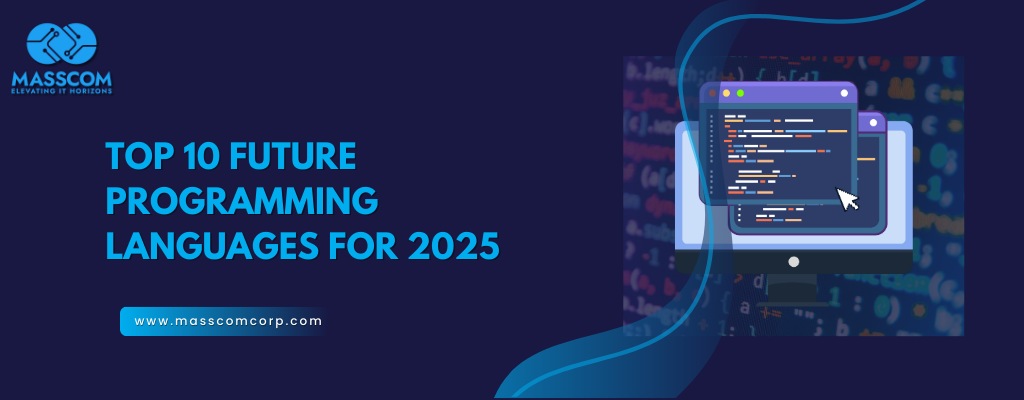Predicting the top programming languages for the future involves considering ongoing trends in software development, emerging technologies, and shifts in the industry. As of 2024, here are 10 programming languages that are likely to play an important role in 2025 and beyond:
1. Rust
Why it’s on the rise: Rust is known for its safety, performance, and memory management features. It’s gaining popularity in areas like systems programming, embedded development, and high-performance computing. As the need for more secure and efficient software grows, Rust is becoming the language of choice for many developers.
Usage: Systems programming, blockchain, game development, web assembly, IoT.
2. Python
Why it’s on the rise: Python continues to be a dominant force in data science, machine learning, AI, web development, and automation. With frameworks like Django and Flask for web development and libraries like TensorFlow and PyTorch for AI, Python’s ecosystem continues to grow.
Usage: Data science, AI/ML, web development, automation, scripting.
3. TypeScript
Why it’s on the rise: TypeScript, a superset of JavaScript, provides static typing and improved developer tooling. As web and mobile applications become more complex, TypeScript’s ability to catch errors early in the development process makes it a go-to choice for frontend and backend development.
Usage: Web development, frontend and backend (Node.js), mobile app development.
4. Go (Golang)
Why it’s on the rise: Go is favored for its simplicity, concurrency, and scalability, making it ideal for cloud-native development, microservices, and high-performance applications. As cloud infrastructure and distributed systems become more central, Go is poised to grow in popularity.
Usage: Cloud services, microservices, backend development, DevOps.
5. Swift
Why it’s on the rise: Swift has become the dominant language for iOS and macOS app development. As Apple’s ecosystem continues to expand, Swift’s safety features, performance optimizations, and developer-friendly syntax will keep it a top choice for mobile and desktop app development.
Usage: iOS/macOS development, mobile apps, server-side development.
Lets discuss your next project
6. Julia
Why it’s on the rise: Julia is designed for high-performance numerical computing, making it highly suitable for data science, scientific computing, and large-scale simulations. It combines the speed of C with the ease of use of Python, and its adoption is increasing in research and AI-focused industries.
Usage: Data science, scientific computing, machine learning, AI.
7. Kotlin
Why it’s on the rise: Kotlin is the preferred language for Android development, and it’s gaining ground in backend development as well. With its modern syntax and interoperability with Java, Kotlin is becoming more attractive for building both mobile and server-side applications.
Usage: Android development, backend development, cross-platform apps.
8. Solidity
Why it’s on the rise: Solidity is the primary language for writing smart contracts on blockchain platforms like Ethereum. With blockchain and decentralized finance (DeFi) continuing to expand, Solidity’s role in developing decentralized applications (dApps) will remain critical.
Usage: Blockchain, smart contracts, decentralized applications (dApps), DeFi.
9. Vlang
Why it’s on the rise: V is a statically-typed, compiled programming language that focuses on simplicity, performance, and safety. It promises to be an alternative to Go and Rust with an emphasis on fast compilation and minimal syntax. V is still evolving but has the potential to gain traction in systems programming and application development.
Usage: Systems programming, web development, desktop apps.
10. C# (with .NET 8 and beyond
Why it’s on the rise: C# remains a strong contender, particularly with the evolving .NET platform. With Microsoft’s continued investment in .NET 8 and cross-platform capabilities, C# is expected to continue powering enterprise applications, games (via Unity), and cloud-native services.
Usage: Enterprise applications, game development (Unity), cloud computing, web development.
Honorable Mentions:
- Dart (for Flutter cross-platform app development)
- F# (functional-first language gaining popularity in data science and finance)
- Haskell (continues to be important in academia and functional programming spaces)
- Zig (a systems programming language with a focus on simplicity and performance)
- R (still dominant in statistical analysis and data science, though facing competition from Python).
The programming languages of 2025 will likely be shaped by advancements in AI, cloud computing, blockchain, and systems programming. Rust, Go, TypeScript, Python, and Swift are particularly poised to lead, but emerging languages like Julia and V could offer fresh paradigms and improvements in performance and safety.


